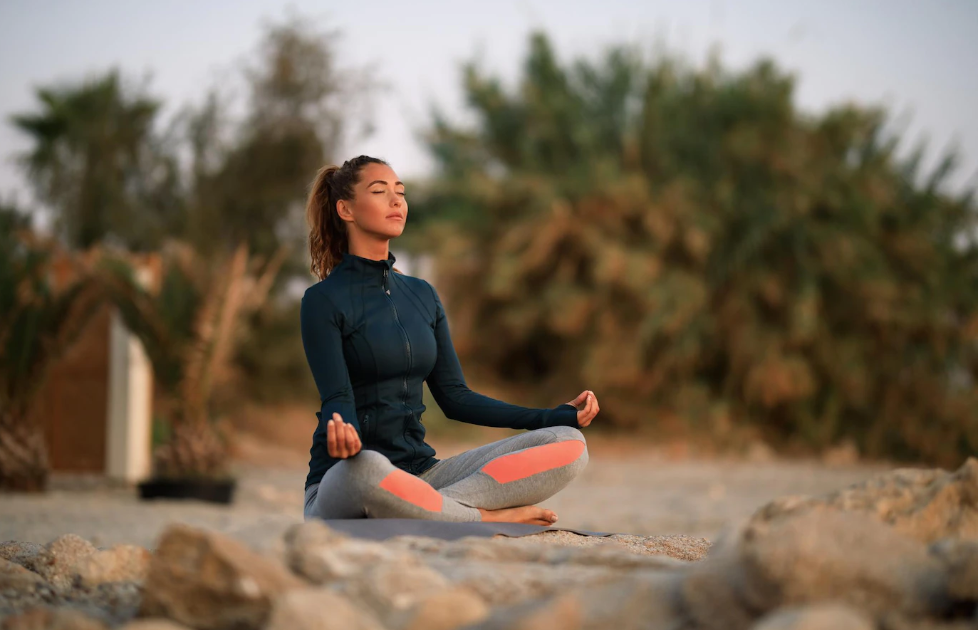Meditation Breathing
Discover how meditation and breathing can help the body to access rest and relaxation.

Selfpause Affirmation App
Download the app to get 1,000’s of affirmation meditations and everything you need to write, record and listen to your own.
Alternate nostril breathing has several benefits for meditation, and it can improve the flow of energy throughout the body. It helps the body to relax and improves the functioning of the brain. It reduces bound free radicals and improves memory and cognition. By increasing the flow of oxygen to the brain, Alternate Nostril Breathing also helps the body to access rest and relaxation more effectively.
One of the most important benefits of alternate-nostril breathing is that it reduces anxiety and stress. This technique is very easy to learn and practice. It’s a great way to relax before stressful situations. Whether you’re in the middle of a work project or presenting to the public, practicing alternate nostril breathing before a presentation will reduce your stress levels.
To start practicing alternate nostril breathing, find a quiet, well-ventilated area to sit and relax. Use your ring and little fingers to close each nostril. Breathe in through your left nostril, hold for 8 counts, and release into your right nostril. Repeat the process several times.
To begin the practice of alternate nostril breathing for meditation, first place yourself in a comfortable position. Then place your left hand on your left knee with the palm facing upward. Next, place the tip of your right hand on your forehead, between your eyebrows. Close your left nostril with your ring finger, while your right nostril is closed with your thumb. Repeat this process three more times, alternating your fingers and thumb, until you’ve completed all three cycles.
Alternate nostril breathing is a basic meditation technique that engages the whole brain. By engaging both hemispheres, it affects the glandular system, as well as the brain’s mood. As a result, the left nostril is associated with the Ida Nadi, while the right nostril is associated with the Pingala Nadi, the right nostril connects with solar energy.
When used for meditation, alternate nostril breathing has many benefits. It can relieve stress and act as a reset button. The key is to be consistent with your practice. Start with a five-count inhale and exhale. You can increase this number as you get better at it.
Kumbhaka pranayama

The Kumbhaka pranayama for mediation breathing exercise involves drawing air in through the left nostril and exhaling it out through the right nostril. Inhaling should be slow and rhythmical and should produce a characteristic sound. Repeat the exercise six times a day, in the morning and evening. As you become more familiar with the technique, you can increase the number of rounds.
Kumbhaka Pranayama is an advanced form of meditation breathing. When done correctly, it strengthens the diaphragm and expands lung capacity. The goal is to achieve stillness of mind and a state of complete relaxation. This breathing technique has several benefits, including improved concentration and overall health.
Pranayama is considered an important practice to develop concentration and a strong will. It also helps to regulate the circulatory system and improves digestion. When practiced properly, it can even help cure certain ailments. For instance, a sluggish liver can be treated through Pranayama. It’s a very effective way to improve your health.
When performing Kumbhaka, make sure you follow the correct procedure. The key is to breathe through both nostrils. During the exhalation, you should hold your breath for about twice as long as the natural inhalation. When you start practising Kumbhaka, you should be familiar with the three bandhas. If you are able to master these bandhas, you can then practise Antar kumbhaka.
Kumbhaka pranayama is a technique that requires a sitting posture. It should also open the Muladhara chakra and awaken the Kundalini. When practiced regularly, the Kundalini will begin to awaken very quickly. When this happens, you’ll find that you’re in the flow of meditation.
If you practice Kumbhaka regularly, you can impart healing powers to others. When you practice Kumbhaka, you’re giving yourself Prana, which will replenish you at the cosmic level. By delivering Prana to others, you are helping them heal, and this is the law of nature. Whether you’re a patient with rheuma or a rheumatic condition, practising Kumbhaka regularly can help.
As you practice Kumbhaka pranayama, you need to regulate each part of your breathing. If you take too long in one part, it can disturb your breathing rhythm. The more you practice, the more you’ll get better at it.
Mindful breathing

One of the main benefits of mindful breathing during meditation is that it is a great distraction-buster. It also improves self-awareness, and can calm a racing mind. With practice, this meditation technique becomes easier and more relaxing. It also incorporates a mental cue that helps with concentration, such as counting your breaths. This practice can also help control high blood pressure and improve memory.
To start practicing mindful breathing, you should sit or lie down in a quiet space. If possible, you can use headphones to keep your attention focused on your breathing. You should practice this meditation for at least five to seven minutes at a time. It is best to do this early in the morning, and before caffeine intake. The ideal position for practicing mindful breathing is on your stomach or on your back. The goal is to notice any distractions, such as thoughts, and then return your attention to your breathing.
During the practice of mindful breathing, you can reduce feelings of anxiety and boost your mood. It also activates the parasympathetic nervous system, which lowers blood pressure and heart rate. It also helps reduce feelings of cynicism and emotional exhaustion. Mindful breathing during meditation can help people in many different areas of their lives, including work, relationships, and health.
Mindful breathing during meditation can also help people who are suffering from depression. This type of meditation can reduce negative and repetitive thoughts and reduce the intensity of pain. It can help people overcome their depression by allowing them to experience the benefits of mindfulness without the need for drugs. When practiced regularly, this type of meditation can lead to reduced stress and anxiety.
Practicing mindful breathing during meditation is a great introduction to meditation and can make the transition easier. By paying attention to how you breathe, you can focus on how it affects your body. For example, you can focus on how deep and long your breath is. You can also observe how each breath feels in your chest or belly.
Research on mindfulness and meditation is still developing. The benefits of this practice are not clear, however. It is difficult to determine whether this practice has an impact on the development of cognitive and affective processes.
Rhythmic breathing

Rhythmic breathing is an important part of meditation. It helps you to slow down and focus on the breathing process. When you are practicing rhythmic breathing, you should focus on breathing in and out in the same rhythm. Try to make your inhalations and exhalations about the same length, for example, taking four breaths in and exhaling two.
Rhythmic breathing is a fundamental technique used during many meditation practices and yoga practices. It helps to promote relaxation and reduce stress. It is also easy to learn and can be practiced by anyone at any age and any health condition. Most of us do not even think about our respiratory system, and as such, we breathe irregularly. Rhythmic breathing trains our inflow and outflow into a specific rhythm, which reduces stress and wear on our internal organs.
Researchers have found that rhythmic breathing has the potential to reduce physiological stress, especially when combined with traditional meditation practices. According to Brown et al., this practice significantly reduced the symptoms of PTSD, hyperarousal, re-experiencing, and anxiety. Studies of this practice have also shown that it helps preserve cognitive reserves, thereby improving sustaining performance.
When used properly, rhythmic breathing can also be an effective training aid in running. It helps reduce stress and injury by allowing the diaphragm to relax during the initial stages of exhalation. This increases the volume of the chest cavity, which draws more air into the lungs. By focusing on your breathing, rhythmic breathing allows you to stay in a relaxed mental state.
Rhythmic breathing increases the oxygen in your body, which improves energy levels. It also reduces stress by allowing your body to experience perfect rest. Over time, rhythmic breathing will become a habitual way of breathing and will lead to a healthier, happier mind. If you practice it every day for a few minutes each day, you should start seeing results within a short time.
Deep breathing exercises also enhance your mood and reduce stress levels. The technique can be practiced when you have spare time, while you wait for the bus or walk to the office. Ideally, you should do this exercise with a non-full stomach and at least three hours have passed since your last meal.
Our Top FAQ's
The benefits of meditation breathing include reduced stress and anxiety, improved concentration and focus, increased mindfulness and awareness, and enhanced overall well-being.
To properly practice meditation breathing, find a comfortable and quiet place to sit or lie down. Close your eyes and focus on your breath, paying attention to the sensation of the air entering and leaving your body. Try to let go of any distracting thoughts and maintain a relaxed, yet alert, state of mind.
Yes, meditation breathing can be effective in reducing stress and anxiety. By focusing on the breath, you can calm the mind and bring yourself into a more relaxed state, which can help to alleviate feelings of stress and anxiety.
The relationship between breath and mindfulness in meditation is that the breath is often used as a point of focus to cultivate mindfulness. By paying attention to the breath, you can train the mind to be more present and aware in the moment, which is a key aspect of mindfulness.
Yes, there are different types of meditation breathing techniques, including deep breathing, abdominal breathing, and alternate nostril breathing. These techniques can be used to enhance the relaxation and mindfulness benefits of meditation.
